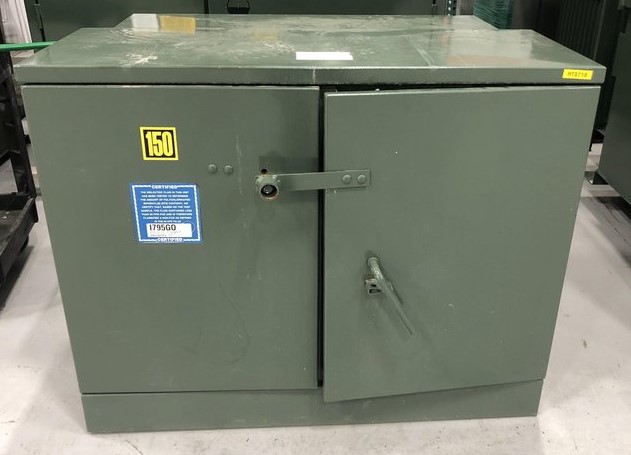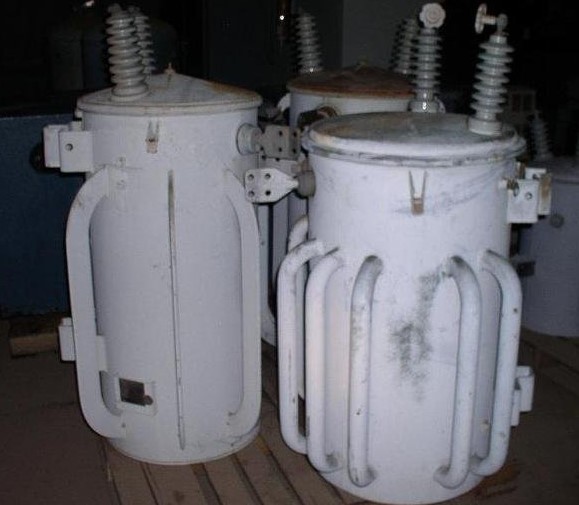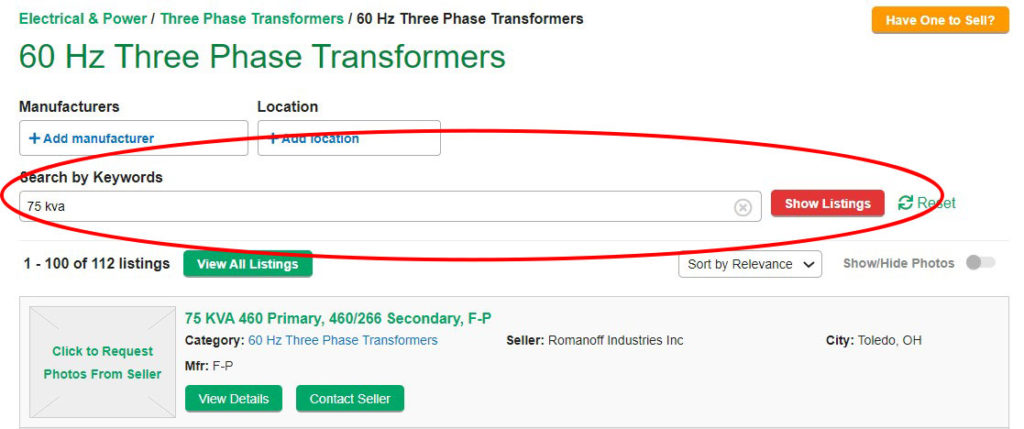A distribution transformer is a piece of heavy-duty equipment that modifies the regular high voltage to an output of 240/120V before distributing electricity. There are different types of distribution transformers. They can range from single-phase transformers, pad-mounted transformers, three-phase transformers, pole distribution transformers, and underground mounted transformers. If you already have an idea of what you’re looking for, check out our Advance Transformer Search to find exactly what you need.
What is a Distribution Transformer Used for?

Transformers serve a variety of purposes, but simply put, a transformer is a machine that transfers electricity between two circuits while changing voltage. There are a variety of transformers available, and some are better suited for different purposes than others. You can install a distribution transformer at a service drop, the point where wires are connected either via a utility pole or power lines under the ground and sent to end-users. Distribution transformers are normally used to provide power to isolated properties, pumping stations, or farmyards at 30kv. You can also find distribution transformers in wind farms. There they are used to step up power via the wind turbines.
The invention of what we now know as the transformer can be traced back to the 1800s. The journey began with English scientists, Michael Faraday and Joseph Henry who discovered electromagnetic induction. They determined that a changing magnetic field can induce a current of a higher voltage (known as “stepping up”) or a lower one (“stepping down”).
It wasn’t until 1885 that several other engineers would develop the first useful transformer prototypes. A year later, three engineers working for George Westinghouse designed what soon became the classic Stanley transformer: an iron core comprised of thin silicon steel laminations, with one part shaped like the letter “E” and the other like an “I” to make it easy to slide wound copper coils into place. This innovation was put to use heavily in the United States for the distribution of power and has served as the standard for the supply of electricity since then.
Things you Need to Know Before Buying a Transformer
Before buying a distribution transformer you must consider the following factors:
- Input and Output Voltage – You must consider the input voltage and load voltage going forward. Input voltage means the supply line that needs to match the voltage requirements of the equipment. The load voltage is the voltage needed by the load (equipment) connected to the transformer via the output.
- Frequency – Note that the frequency of a distribution transformer is constant from the supply line to the load connected to it. There’s a chance that a 50 Hz rated unit can operate on a 60 Hz rated unit.
- KVA Rating – KVA is the rating that classifies a distribution transformer. It is also the rating used to classify the capacity of the distribution transformer. This means that it measures the amount of load that a particular transformer can support.
- The Purpose of the Transformer – Are you buying the transformer to serve a large area? Do you want to power large buildings and equipment? Whatever the case is, you can make your decision on which option you need based on the above questions.
- The Environment Will the Transformer be Used in – Depending on the facility and/or the energy requirements of the project, a distribution transformer in a flammable work site will need explosion-proof protection. You can use NEMA-rated enclosures to protect transformers in harsh environments.
- Space Requirements – The mount you want to use will determine the space requirements for the distribution transformer you need. A compact transformer can easily be mounted in tight spaces using wall brackets.
- Standards and Approvals that are Required – If the area has imposed certain standards for mounting transformers, you must consider this before buying a transformer. Make sure you meet the necessary regulations going forward.
- Wire Configuration – Swift power fluctuations can easily damage a transformer and the equipment that’s connected to it. To prevent this from happening, you might need to install fuses, and circuit breakers during the wire configuration to preserve your equipment. These solutions limit the flow of current when there are spikes.
What is KVA and What Does Primary/Secondary Voltage Mean?
The term KVA (Kilovolt-Ampere) can be defined as the ratings used to classify a transformer. You can call it the rating used to classify the capacity of the distribution transformer. Hence, the size or capacity of a distribution transformer is determined by its KVA. The power needed is usually the equivalent of the transformer’s rating in KVA. A 1-Watt load will be powered by a 1KVA of distribution transformer based on energy utility. Typically, current passes through the windings of the distribution transformer.
Primary voltage means the voltage that is applied to the terminals of a primary winding of a distribution transformer. This energy applied to the primary winding must come in a changing form which in turn will create a regular change currently in the primary because it is only a changing magnetic field that produces the current in secondary voltage. While the secondary voltage in distribution transformers is coil supplying output voltage. This voltage can vary depending on load resistances and constant input when it comes to voltage.
Different Types of Distribution Transformers
The factors used to classify distribution transformers can range from:
Mounting location: Pole, Pad, and Underground
This is the position where the transformer will be located. The types of transformers in this case can be divided into a pole, pad, or underground. Is the wiring or distribution line done underground? Is it through electricity poles? Whatever option is used in the area will determine how the transformer will be mounted.


Insulation: Liquid-immersed or Dry-type
Transformers require insulation and this can be used as a basis for classification. Under the heading of insulation, transformers can either be liquid-immersed or dry type. Liquid-filled transformers are typically more efficient, better overload capacity, and last longer than dry-type transformers however they typically require more maintenance due to possible leaks of the liquid.
Phases: Single-Phase or Three-Phase
The most popular types of transformers are single or three-phased. Three-phase means the transformer is divided into three parts and it comes including a coil, a primary winding, and a secondary winding. The term “winding” refers to multiple coils of wires wrapped in a core of metal. Electrical energy is transferred to the primary winding before it is transformed into magnetic energy. The core of the distribution transformer carries this magnetic energy afterward to its secondary winding where the voltage is altered. A single-phase transformer is a type of power transformer that utilizes single-phase alternating current, meaning the transformer relies on a voltage cycle that operates in a unified time phase.
Voltage Class
The voltage requirements for a distribution transformer are basically the capacity of the device. How much load does it have capacity for? The voltage of a distribution transformer can vary depending on load resistances and a constant input. Examples include 30 KVA transformer, 45 KVA transformer, 75 KVA transformer, 100 KVA transformer, etc.
Standard Transformer Sizes
There are high voltage transformers and medium-voltage transformers. The standard transformer sizes in the industry include 15 KVA, 30 KVA, 45 KVA, 75 KVA, 112.5 KVA, 150 KVA, 225 KVA, 300 KVA, 500 KVA, 750 KVA, and 1,000 KVA. We also have transformers that are larger than the above-mentioned sizes when it comes to utility, although these options aren’t common. The larger options are suitable for large projects.
Considerations for Buying the Best Electric Transformer
There’s a broad range of distribution transformers out there to choose from. Depending on your budget, you may want to consider buying used vs new. This equipment can efficiently provide power distribution. They can range from 15 to 2,500 KVA. The capacity of the transformer you choose will be based on your application, capacity, and electricity schedule.
When to Use a 3-phase Pad-mounted Transformer
The phase of the power line that the transformer supplies should match the equipment connected to it (the distribution transformer). The phase is available as either a three-phase or single phase. It comes with three parts, including a coil, a primary winding, and a secondary winding. The voltage changes when the core carries magnetic power to the secondary winding.
A pad-mounted transformer is a distribution transformer that is mounted on the ground (on a concrete pad) inside a steel cabinet. Because the wiring on pad-mounted transformers is enclosed, these types of distribution transformers can be mounted in spaces that don’t have fences. Pad-mounted transformers can also be used with underground power distribution lines. A single pad-mounted transformer can serve one building or many houses.
Determining How much KVA and Voltage You need
Transformers are rated based on VA or KVA. To prevent or reduce overloading, it is ideal to create a buffer that allows you to select a higher size transformer. KVA is the rating that classifies a distribution transformer. It is also the rating used to classify the capacity of the distribution transformer.
Sometimes you’ll see some transformers that are rated in units of VA (volt-amperes). This is common in small-sized transformers. Transformers with a rating of 100 VA can handle more than 100 volts per ampere of current. While a 1.0 KVA transformer is the same capacity as a transformer with a rating of 1,000 VA. This transformer can handle over 100 volts per 10 amperes of current.
How to Calculate the KVA of a Distribution Transformer
To calculate the KVA of the required distribution transformer, base your findings on your electrical schematics. You must determine the electrical load connected to the secondary winding coil and this can be seen on the electrical schematic. After this, you must determine the current flow your energy load requires via the schematic.
Without locating the necessary current flow, calculate the KVA by dividing the transformer’s input voltage by its resistance. After locating these two figures, use them to determine your power requirements. To do this, multiply the input voltage needed by the required current load and divide the total by 1,000.
When to Use a Custom Electrical Transformer
Generally, you’ll need a custom transformer when you have to power large buildings and industries. Your decision to get a distribution transformer depends solely on what you need to power. Many circumstances would warrant a custom transformer. If the generic option cannot support your property, you might need to get a custom transformer.
Real World Applications and Uses
Transformers are used in a wide variety of applications. Below are just a few examples of everyday uses:
- Electrical power distribution to homes and business
- Manufacturing of metals via electrolysis
- Powering railways
- Battery charging
- Chemical engineering and manufacturing processes
- Crypto currency Mining
Finding Transformers on Surplus Record
Buying a transformer is not necessarily an overwhelming task. Start by recognizing the purpose and your unique needs and follow the above considerations to help you choose the right piece of equipment. No matter your reasons for buying a distribution transformer, whether you need it to supply power to a startup, an existing area, or large buildings, Surplus Record can help. We work with several dealers who specialize in transformers.
All our Transformer listings follow the same easily identifiable titles. They go by KVA, Primary Voltage, Secondary Voltage, Manufacturer, and will typically end with the enclosure type, or model number of the transformer. This allows you to quickly read down the list of transformers while in the same grouping of voltage.
ie: 75 KVA 240 Primary, 208Y/120 Secondary, Hammond, dry type, Nema 3R
With our newly redesigned website, searching is a breeze. Use the search bar in the header of our website to perform a basic search.
Manufacturers include General Electric, Westinghouse, Square D, Abb, and more.
We also work with several dealers who specialize in transformers of various types. You can also find dealers in your area or by name who specialize in transformers.
You can also search by KVA. For example, if you’re in the Three Phase Transformer category page, you can search within it under the “Search By Keywords” option. Just enter in “75 KVA” and hit Show Listings, it will pull up all the 75 KVA transformers instantly.


